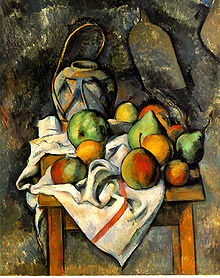Barnes Foundation
The Barnes Foundation is a college in Pennsylvania . The institution, founded in 1922 by Albert Coombs Barnes , has its headquarters in Merion, a suburb of Philadelphia . There is an arboretum and a library for horticulture. The art collection, exhibited at the same location until 2011, has been open to the public since May 19, 2012 in a new building on Benjamin Franklin Parkway in Philadelphia. The art collection includes masterpieces of French Impressionism and Late Impressionism .
origin
The Barnes Foundation was founded in 1922 by Albert Coombs Barnes as a college of philosophy and art. This institution emerged from lectures and discussion events which Barnes himself led in his pharmaceutical factory and to which he invited scholars such as William James , Bertrand Russell and John Dewey . Barnes paid particular attention to the education of the lower social classes. At a time when racial segregation still existed in the USA, Barnes felt particularly attached to the Afro-American population and not only encouraged them as students, but was also interested in their culture and art.
Albert C. Barnes amassed a considerable art collection (181 Renoirs , 69 Cézannes , 60 Matisse , 46 Picassos , 21 Chaim Soutines and 18 Rousseaus ; in addition, works by Amedeo Modigliani , Degas , van Gogh , Seurat , Monet , old masters, African sculptures , as well as works by Afro-American artists). He donated this collection to the Barnes Foundation. Barnes developed his own system of art education, which was mainly based on teaching the students right in front of the original pictures.
The art collection moves to Philadelphia
According to its founder, the Barnes Foundation does not see itself as a museum. Due to the nature of the teaching, the non-student public was only able to visit this collection on weekends and during the holidays - by prior arrangement. The Barnes Foundation's headquarters in Merion is in an upscale residential area outside of Philadelphia. This led to the fact that a residents' initiative was founded, which by court decision restricted the traffic of visitors by car and prohibited all bus traffic. This allowed only 250 visitors a week to view the collection. As early as the 1990s, the Barnes Foundation ran into financial difficulties due to management errors. The art collection was worth more than $ 2 billion, but there was no money for necessary repairs. The buildings had not been renovated since 1923 (heating, alarm system etc.) and teaching was in danger of being stopped. Some of the paintings were discussed for sale. Barnes' will was challenged in court. He had u. a. decrees not to allow any color reproductions of the paintings and never to loan any of the paintings. The court ruled, however, that color reproductions and an exhibition tour to Paris, Munich, Tokyo, Toronto, Washington and Philadelphia were permitted in order to preserve the collection and continue teaching. With the loan fees that the respective museums had to pay, the sale of catalogs and corresponding souvenir items, enough money was initially generated to renovate the buildings and continue teaching. Since the financial situation of the Barnes Foundation did not improve permanently, various foundations agreed to secure the future of the Barnes Foundation in the long term. The condition, however, was a change in management and the complete relocation of the art collection from its location in Merion to Benjamin Franklin Parkway in Philadelphia, where the Philadelphia Museum of Art is already located. The collection is there in a new building designed by the architects Williams / Tsien and is open to a larger public, with appropriate facilities (bookstore, restaurant) designed for larger numbers of visitors. The new building and relocation was based on a compromise agreed in a court order, which provided for a reproduction of the interior of the building in Merion, including the original hanging of the works of art. The new building, which opened at the end of May 2012, was applauded by the NZZ cultural correspondent. The 2010 film The Art of the Steal, on the other hand, criticized the move as a seizure of power by the three billionaire families Annenberg , Lenfest and Pew , who rival Barnes .
gallery
Paul Cezanne:
The Card Players
literature
- John Anderson: Kind of Hero Hostage. The Battle Over the Barnes Collection. WW Norton, New York 2003, ISBN 0-393-04889-6 .
- Exhibition catalog Munich: La joie de vivre / The never-seen masterpieces of the Barnes Collection. Kindler 1993, ISBN 3-463-40221-1 .
- Constance L. Hart: Rest in Peace Dr. Barnes. The story of the Barnes Foundation. With a discussion of the fate of selected private collections in America . Dissertation, Columbia University, New York 1995.
See also
Web links
- Official website
- Pew Charitable Trust: The Barnes Foundation Petitions Court to Move Gallery into Philadelphia ( August 21, 2004 memento on the Internet Archive )
Individual evidence
- ↑ Andrea Köhler in the NZZ of June 2, 2012: Contested, threatened and revitalized - In a fresh light: the legendary Barnes Foundation in Philadelphia , accessed on June 7, 2012
- ↑ See Lars Jensen: The Revenge of the Rich. In: Frankfurter Allgemeine Sonntagszeitung, April 25, 2010, page 26. (for a fee in the archive ; the English translation of the article is available online as a PDF file .)
Coordinates: 39 ° 59 ′ 52.6 " N , 75 ° 14 ′ 26.1" W.











